
Home - Search - Browse - Alphabetic Index: 0- 1- 2- 3- 4- 5- 6- 7- 8- 9
A- B- C- D- E- F- G- H- I- J- K- L- M- N- O- P- Q- R- S- T- U- V- W- X- Y- Z
STS-4
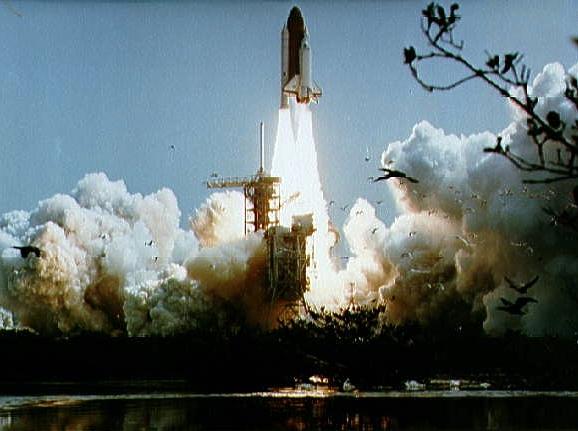
STS-4
Launch view of the STS-4 mission
Credit: NASA
AKA: Columbia. Launched: 1982-06-27. Returned: 1982-07-04. Number crew: 2 . Duration: 7.05 days.
Payloads: Induced Environment Contamination Monitor (IECM), Monodisperse Latex Reactor (MLR), Continuous Flow Electrophoresis System (CFES), Development Flight Instrumentation (DFI), Orbiter Experiments (OEX), first NASA getaway special (GAS), Night/Day Optical Survey of Lightning (NOSL) experiment, Vapor Phase Compression (VPC) freezer heat exchanger dynamics for freezing samples, Aerodynamic Coefficient Identification Package (ACIP) experiment.
Orbits of Earth: 112. Distance traveled: 5,310,835 km. Orbiter Liftoff Mass: 109,616 kg. Orbiter Mass at Landing: 94,774 kg. Payload to Orbit: 11,109 kg. Payload Returned: 11,109 kg. Landed at: Concrete runway 22 at Edwards Air Force Base, Cali. Landing Speed: 378 kph. Touchdown miss distance: 288 m. Landing Rollout: 3,010 m.
NASA Official Mission Narrative
Mission Name: STS-4 (4)
COLUMBIA (4)
PAD 39-A (16)
4th Shuttle mission
4th Flight OV-102
3rd RMS Mission
Crew:
Thomas K. Mattingly (2), Commander
Henry W. Hartsfield (1), Jr., Pilot
Milestones:
OPF - April 7, 1982
VAB - May 19,1982
PAD - May 26, 1982
Payload:
DoD 82-1,CFES(1),CIRRIS,MLR(2),IECM,SSIP(x2),GAS (G-001),VPCF
Mission Objectives:
Launch:
June 27, 1982, 11:00:00 a.m. EDT. Launch proceeded as scheduled with no delays. Launch weight: 241,664 lbs.
Orbit:
Altitude: 197nm
Inclination: 28.5 degrees
Orbits: 113
Duration: Seven days, One hour, Nine minutes, 31 seconds.
Distance: 2,900,000 miles
Hardware:
SRB: BI-004
SRM: 004SW(SPM)
ET : 5/SWT-4
MLP: 1
SSME-1: SN-2007
SSME-2: SN-2006
SSME-3: SN-2005
Landing:
July 4,1982,9:09:31 a.m. PDT, Runway 22, Edwards Air Force Base, Calif. Rollout distance: 9.878 feet. Rollout time: 64 seconds. First landing-on 15.000-foot-long concrete runway at Edwards. Orbiter returned to KSC July 15,1982. Landing Weight: 208,946 lbs
Mission Highlights:
Final Space Transportation System research and development flight. In addition to classified Department of Defense payload, cargo included first Get Away Specials, (G-001) which contained nine experiments from Utah State University; first commercial experiment involving Continuous Flow Electrophoresis System (CFES); Monodisperse Latex Reactor (MLR); Induced Environment Contamination Monitor (IECM), which was deployed, and two Shuttle Student Involvement Program (SSIP) experiments. Crew rock data for two medical experiments on themselves, operated remote manipulator arm to swing IECM around orbiter, and took photos of lightning activity in Earth's atmosphere. Two solid rocket booster casings lost when main parachutes failed and they impacted water and sank. Some rainwater penetrated protective coating of several tiles while orbiter on pad. On orbit, affected area turned toward sun and water vaporized, preventing further tile damage from freezing water.
More at: STS-4.
Family: Manned spaceflight. People: Hartsfield, Mattingly. Country: USA. Spacecraft: Columbia. Projects: STS. Launch Sites: Cape Canaveral. Agency: NASA, NASA Houston.
 | STS-4 Credit: www.spacefacts.de |
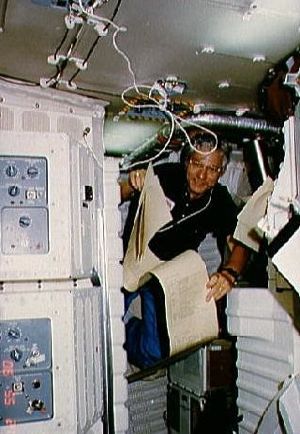 | STS-4 Pilot Hartsfield reviews TAGS teleprinter printout of instructions on middeck Credit: NASA |
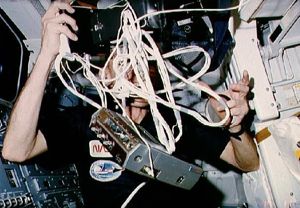 | STS-4 Commander Mattingly tangles with NOSL experiment on aft flight deck Credit: NASA |
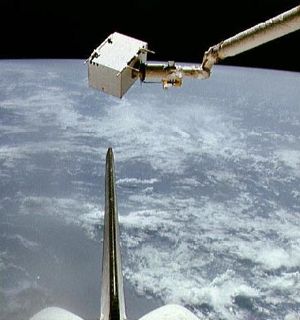 | STS-4 View of the Columbia's RMS arm and end effector grasping IECM Credit: NASA |
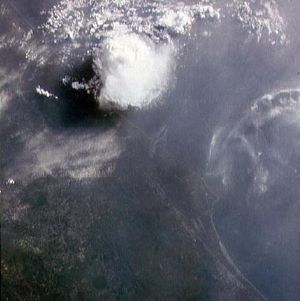 | STS-4 Thunderstorm off Florida coast, USA Credit: NASA |
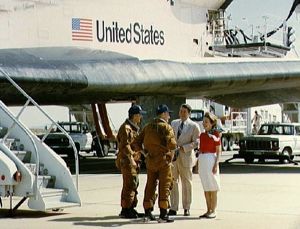 | STS-4 STS-4 landing at Edwards Air Force Base, California Credit: NASA |
 | STS-4 STS-4 landing at Edwards Air Force Base, California Credit: NASA |
1982 June 27 - . 15:00 GMT - . Launch Site: Cape Canaveral. Launch Complex: Cape Canaveral LC39A. Launch Platform: MLP1. LV Family: Shuttle. Launch Vehicle: Space Shuttle.
- STS-4 - .
Call Sign: Columbia. Crew: Hartsfield,
Mattingly.
Payload: Columbia F04 / DoD 82-1. Mass: 11,109 kg (24,491 lb). Nation: USA.
Related Persons: Hartsfield,
Mattingly.
Agency: NASA Houston.
Program: STS.
Class: Manned.
Type: Manned spaceplane. Flight: STS-4.
Spacecraft Bus: Shuttle.
Spacecraft: Columbia.
Duration: 7.05 days. Decay Date: 1982-07-04 . USAF Sat Cat: 13300 . COSPAR: 1982-065A. Apogee: 302 km (187 mi). Perigee: 295 km (183 mi). Inclination: 28.50 deg. Period: 90.30 min.
Manned two crew. Fourth space shuttle test flight. Payloads: Induced Environment Contamination Monitor (IECM), Monodisperse Latex Reactor (MLR), Continuous Flow Electrophoresis System (CFES), Development Flight Instrumentation (DFl), Orbiter Experiments (OEX), first NASA getaway special (GAS), Night/Day Optical Survey of Lightning (NOSL) experiment, Vapor Phase Compression (VPC) freezer heat exchanger dynamics for freezing samples, Aerodynamic Coefficient Identification Package (AClP) experiment.
1982 June 28 - .
- STS-4 - Wakeup Song: Up, Up and Away - . Flight: STS-4. "Up, Up and Away".
1982 June 29 - .
- STS-4 - Wakeup Song: Hold That Tiger - . Flight: STS-4. "Hold That Tiger" by Auburn University Band.
1982 July 2 - .
- STS-4 - Wakeup Song: Chariots of Fire - . Flight: STS-4. "Chariots of Fire" theme.
1982 July 3 - .
- STS-4 - Wakeup Song: Delta Tau Delta Fraternity Song - . Flight: STS-4. "Delta Tau Delta Fraternity Song" College fraternity song for TK Mattingly, and Delta Chi for Hank Hartsfield..
1982 July 4 - .
- STS-4 - Wakeup Song: This is My Country - . Flight: STS-4. "This is My Country".
1982 July 4 - .
- Landing of STS-4 - . Return Crew: Hartsfield, Mattingly. Nation: USA. Related Persons: Hartsfield, Mattingly. Program: STS. Flight: STS-4. STS-4 landed at 16:09 GMT. .
Back to top of page
Home - Search - Browse - Alphabetic Index: 0- 1- 2- 3- 4- 5- 6- 7- 8- 9
A- B- C- D- E- F- G- H- I- J- K- L- M- N- O- P- Q- R- S- T- U- V- W- X- Y- Z
© 1997-2019 Mark Wade - Contact
© / Conditions for Use